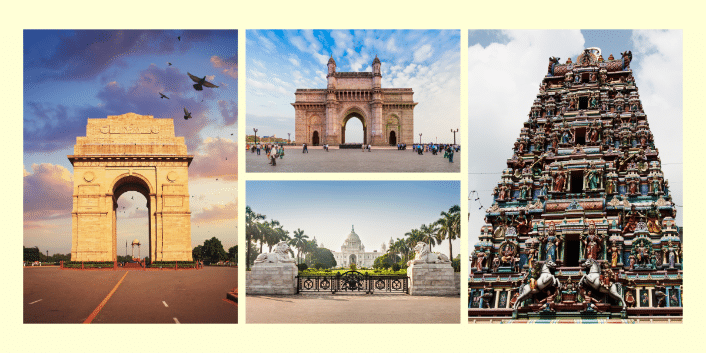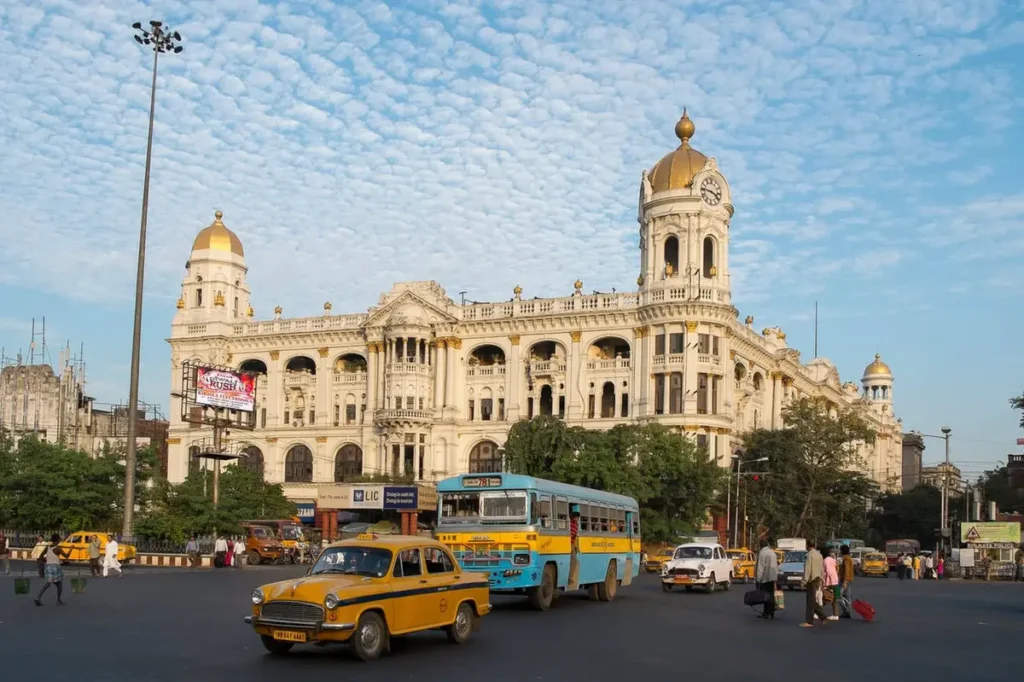
Quick Summary
Table of Contents
India, with a population exceeding 1.4 billion, is witnessing rapid urbanization. Nearly 35% of its people reside in urban areas, with a significant portion concentrated in major metro cities. These cities are the engines of India’s economic growth, contributing over 60% to the national GDP. Renowned metropolitan cities in India like Mumbai, Delhi, Bengaluru, and Chennai serve as hubs for business, culture, innovation, and opportunity.
But what exactly defines a metro city in India? These urban giants stand out beyond population size and infrastructure due to their advanced public services, diverse demographics, and strong economic ecosystems. Each city carries a unique identity shaped by historical, cultural, and industrial influences. This article delves into India’s most prominent urban centers’ key characteristics, significance, and challenges.
Whether you’re a student, a professional, or someone curious about how many metropolitan cities are in India, this comprehensive guide will walk you through the list of metro cities in India, their defining traits, and what sets them apart from other cities.
A metro city in India is a thriving urban center that stands out due to several defining features. These include a large population, often running into millions, and dynamic urban infrastructure. Metro cities bustle with economic activity, drawing diverse communities and industries into a vibrant ecosystem.
Key characteristics of a metro city in India include robust public transportation networks, modern residential and commercial zones, and advanced public services designed to support high population densities. These cities are population centers and economic powerhouses contributing significantly to national progress.
Metro cities like Mumbai and Bengaluru exemplify this status. Mumbai (Maharashtra) is a central financial and commercial hub celebrated for its fast-paced economy and cultural vibrancy. Bengaluru (Karnataka), often called the “Silicon Valley of India,” is known for its booming IT sector and cosmopolitan culture.
Other metro cities in India also play equally vital roles:
Each of these metro cities stands as a beacon of social, economic, and technological advancement. They are integral to India’s growth story and offer access to world-class healthcare, education, and global connectivity.
Criteria for Classification:
Currently, India officially recognizes 8 metro cities, also called metropolitan cities or Tier-1 cities. These cities are characterized by their large populations, extensive infrastructure, and significant economic influence. They are key hubs for finance, technology, governance, education, and culture.
The question “How many metropolitan cities in India?” or “How many metro cities in India?” is commonly asked by students, competitive exam aspirants, and curious readers. According to the Government of India and urban development data, the following cities currently hold metro city status:
These eight cities meet multiple urban criteria, such as population size (usually over 1 million), economic activity, modern amenities, and national or global connectivity. Due to their strategic importance, they also receive special infrastructure and development support from central and state governments.
With India’s fast-paced urbanization, more cities may qualify for metro status in the coming years. However, as of now, 8 metro cities in India are officially designated as such.
Below is a table listing India’s major metropolitan cities, their respective states, and estimated populations.
| Metropolitan City | State | Approximate Population |
|---|---|---|
| Mumbai | Maharashtra | 18 million |
| Delhi | Delhi | 16 million |
| Kolkata | West Bengal | 14 million |
| Chennai | Tamil Nadu | 8.6 million |
| Bengaluru | Karnataka | 8.5 million |
| Hyderabad | Telangana | 7.6 million |
| Ahmedabad | Gujarat | 6.3 million |
| Pune | Maharashtra | 5.05 million |
| Surat | Gujarat | 4.5 million |
1. Mumbai (Maharashtra): Known as the financial capital of India, Mumbai is home to the Bombay Stock Exchange (BSE), Reserve Bank of India (RBI), and several multinational corporations. It also hosts the Hindi film industry, Bollywood. The city is famous for its vibrant nightlife and cultural festivals, and as a port city, it handles significant maritime trade.

2. Delhi (National Capital Territory): Delhi is India’s political and administrative heart. It houses major government offices, the Parliament, the Supreme Court, and foreign embassies. With historical sites like Red Fort and Qutub Minar, Delhi blends heritage with modern infrastructure. It is also part of the NCR (National Capital Region), enhancing its urban expanse.

3. Kolkata (West Bengal): Known as the “City of Joy,” Kolkata is rich in cultural heritage, literature, and arts. It was the capital of British India and still carries colonial-era architecture. It is a significant educational, commercial, and port city in Eastern India.

4. Chennai (Tamil Nadu): Dubbed the “Detroit of India,” Chennai has a strong automobile and manufacturing sector. It also plays a key role in South India’s cultural and economic framework, with prominent IT parks, educational institutions, and healthcare facilities.

5. Bengaluru (Karnataka): Bengaluru, or Bangalore, is India’s tech capital and is referred to as the “Silicon Valley of India.” It is the headquarters for numerous IT companies, startups, and R&D centers. With a youthful population and pleasant climate, it’s a leading city for innovation and lifestyle.

6. Hyderabad (Telangana): Hyderabad blends history with modernity. The Nizams once ruled it and is famous for its palaces and cuisine. Today, it’s a growing IT and biotech hub, home to HITEC City and numerous global tech giants.

7. Ahmedabad (Gujarat): A fast-developing industrial city, Ahmedabad is central to Gujarat’s textile and diamond industries. It has seen significant infrastructure growth and is known for its planned urban spaces, historical landmarks, and educational institutions.

8. Pune (Maharashtra): Often called the “Cultural Capital of Maharashtra,” Pune is known for its vibrant arts scene and educational institutions. It is also an IT and automobile manufacturing hub, making it a balanced city for business and lifestyle.

Metro cities in India play a significant role in the nation’s social, economic, and cultural development. These cities are the engines of growth, contributing to nearly half of the country’s GDP. Here’s an overview of their role:
Metro train systems have become a defining feature of India’s urban transportation landscape. These modern rail networks provide an efficient, reliable, and eco-friendly solution to urban mobility challenges in densely populated cities.
Metro train systems have become a hallmark of modern urban transport in India. These high-capacity railways offer fast, affordable, and environment-friendly commuting solutions across congested cities. The journey began in 1984 when Kolkata Metro became the first metro rail network in India, setting a precedent for mass rapid transit in the country.
Following Kolkata’s lead, cities like Delhi, Bengaluru, Chennai, Hyderabad, and Mumbai developed their own metro systems. Among these, the Delhi Metro stands out for its scale and efficiency. Launched in 2002, it rapidly expanded to cover over 350 kilometers, connecting vast urban and suburban zones. Known for its punctuality, cleanliness, and sustainability, the Delhi Metro has set benchmarks in energy-efficient infrastructure and modern urban mobility.
The rise of metro systems has revolutionized how people move within cities. One of the most critical impacts has been the reduction of traffic congestion. In highly populated metro cities, thousands of commuters now rely on metro trains, easing the burden on road networks.
Additionally, metro trains help improve air quality by reducing the number of personal vehicles and diesel-powered buses on the roads. Operating primarily on electricity, they are a cleaner alternative contributing to environmental sustainability.
Metro systems have also enhanced last-mile connectivity by integrating with feeder buses, e-rickshaws, and ride-sharing services. They enable faster, safer, and more comfortable travel across city zones, greatly benefiting daily commuters. By saving time and lowering travel stress, metro systems also help improve work-life balance and urban productivity.
Metro cities in India face several challenges that affect the quality of life for their residents. These challenges are primarily a result of rapid urbanization, population growth, and the strain on resources and infrastructure.
Metro cities face the challenges of overpopulation, affecting housing, transportation, and infrastructure.
With the added strain on public services, the cost of living rises, making it challenging for many to afford basic needs. By understanding the effects of overpopulation on infrastructure, you’ll see the challenges cities face in providing a sustainable and high-quality living environment for everyone.
In metro cities, pollution is a significant issue that harms the environment and public health. As the population grows and industries expand, air and water pollution worsens.
These initiatives show a growing commitment to reducing pollution and building a healthier, more sustainable future. By understanding these environmental challenges, you’ll see how urban growth and environmental care are deeply connected. You can be part of the solution, too.
India’s metro cities are the lifelines of its urban and economic growth. Only 8 metropolitan cities in India are recognized as necessary in development planning and governance. As urbanization accelerates, new names may soon join this elite list. Understanding the dynamics of each metro city is essential for students, professionals, and policymakers alike. By exploring the list of metro cities in India and their distinct characteristics, we gain deeper insights into the structure of modern India and the cities shaping its future.
India currently has 8 officially recognized metro cities. These cities are:
Mumbai – Maharashtra
Delhi – National Capital Territory
Kolkata – West Bengal
Chennai – Tamil Nadu
Bengaluru – Karnataka
Hyderabad – Telangana
Ahmedabad – Gujarat
Pune – Maharashtra
These cities are considered metropolitan cities based on their large populations, developed infrastructure, economic significance, and role in national growth. They are also categorized as Tier-1 cities in many government and industry classifications.
The term “5 city metro” typically refers to the first five Indian cities with operational metro systems: Kolkata, Delhi, Bengaluru, Chennai, and Hyderabad. These cities pioneered modern urban transport with efficient, high-capacity metro rail networks.
The No. 1 metro in India is widely considered to be the Delhi Metro. It is the country’s largest and most advanced metro rail system, known for its extensive network, punctuality, safety, cleanliness, and energy efficiency. Spanning over 350 kilometers and serving millions daily, it has transformed urban mobility in Delhi and surrounding regions.
The smallest city in India by population is often considered to be Kapurthala in Punjab or Mokokchung in Nagaland among officially recognized urban areas. However, in terms of smallest area and population combined, Bhilai Charoda in Chhattisgarh or Gangtok in Sikkim are frequently cited, depending on the parameters used (area, population, or urban status).
Mumbai has the highest GDP among all metropolitan cities in India. As the country’s financial capital, it contributes significantly to national income through industries like finance, entertainment, trade, and services. Mumbai alone accounts for over 6% of India’s total GDP, making it an economic powerhouse and the top metro city in terms of economic output.
The best metropolitan city in India for working professionals is widely considered to be Bengaluru (Karnataka). Known as the “Silicon Valley of India,” Bengaluru offers a thriving job market in IT, startups, and R&D, along with a cosmopolitan lifestyle, pleasant climate, and a strong network of coworking spaces, cafes, and tech communities.
Other great options include:
Hyderabad – Known for its booming IT sector and affordable living
Pune – Popular for its education, tech jobs, and relaxed work culture
Mumbai – Ideal for finance, media, and global corporate roles
A metropolitan city is typically defined as an urban agglomeration with a population exceeding 1 million (10 lakh) or more than 4 million, depending on the context. A metro city also includes contiguous municipalities or panchayats designated by official notification.

Authored by, Muskan Gupta
Content Curator
Muskan believes learning should feel like an adventure, not a chore. With years of experience in content creation and strategy, she specializes in educational topics, online earning opportunities, and general knowledge. She enjoys sharing her insights through blogs and articles that inform and inspire her readers. When she’s not writing, you’ll likely find her hopping between bookstores and bakeries, always in search of her next favorite read or treat.
Editor's Recommendations
Chegg India does not ask for money to offer any opportunity with the company. We request you to be vigilant before sharing your personal and financial information with any third party. Beware of fraudulent activities claiming affiliation with our company and promising monetary rewards or benefits. Chegg India shall not be responsible for any losses resulting from such activities.
Chegg India does not ask for money to offer any opportunity with the company. We request you to be vigilant before sharing your personal and financial information with any third party. Beware of fraudulent activities claiming affiliation with our company and promising monetary rewards or benefits. Chegg India shall not be responsible for any losses resulting from such activities.